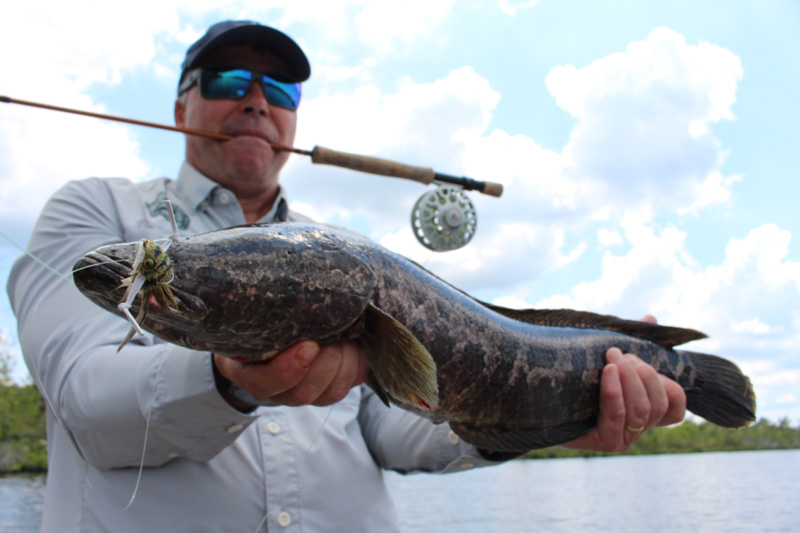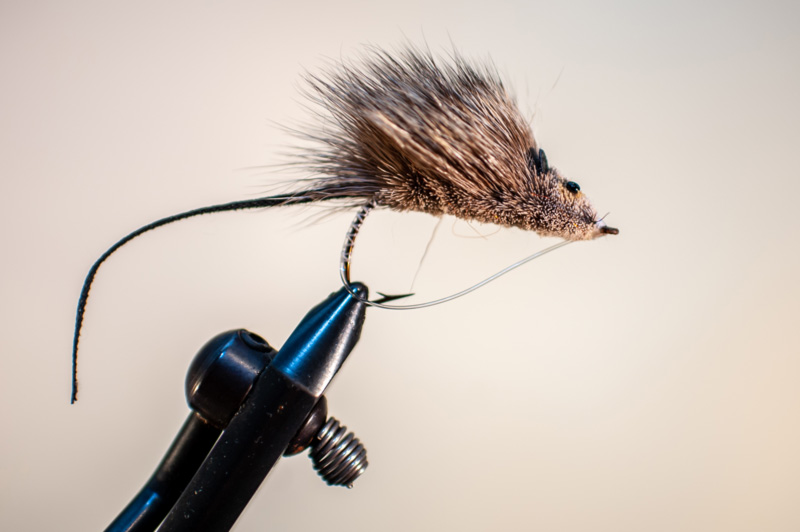Though the striped bass is the king of the Chesapeake, the growing popularity of fishing for northern snakehead has exploded in recent years. And with this notoriety as a hard-fighting and delicious gamefish, many different types of snakehead anglers have emerged. There are the patient bait anglers who intensely watch their cork as they lean on a roadside guardrail, in the hopes that the float gives a slight hint of a panicking minnow before the whole thing dives under the water. There are the fast-moving chatterbait anglers who cover miles of water in a day and get ferocious slams when they find a fish hanging out on the edge of a patch of lilies. There are the topwater anglers, which can be divided into two categories: the fast fishers, who know a strike is imminent by seeing the telltale wake coming after a frog or mouse, as opposed to the patient and methodical slow topwater anglers, who dissect the cover and will go up to 30 seconds in between twitches to really tick-off the dragons and get them to pounce. Everyone has a favorite style, and all of them are fun.

It is my personal philosophy that when I get proficient at fishing for a species, the logical next step is to grab my fly rod. What could be better than tricking a fish with something I tied myself, then fighting the monster on a flexible, yet strangely powerful fly rod?
Snakehead Fly Fishing Gear
Fly Rod
Even the stoutest fly rods do not compare to a heavy, fast action casting rod, yet all over the world anglers catch fish like tarpon, billfish, and even mako sharks on fly gear. Fortunately, for snakehead you will not need a 12-weight rod with a reel that has 300 yards of backing. Much of the gear you will need is probably available at your local tackle store. Just like with conventional gear, you will want to upsize your fly gear so you do not need to use your rod's warranty. I have caught large fish on light tackle and seen people catch bigger fish on lighter tackle — the biggest gap I witnessed was a man steelhead fishing with a three-weight and catching big fish in fast-flowing rapids — but only the most diehard fly anglers would go for snakehead with anything smaller than a six-weight. The vicious headshakes of a snakehead do have the potential to smash a flexible rod if the angler is not fully prepared for a sudden move. To be on the safe side, I recommend a nine-foot, seven- or eight-weight rod. Despite feeling heavy for the task, an eight-weight will give you the backbone you need but still allow you to enjoy the fight.
Fly Line
Your fly line does not need to be anything special. Most snakehead fishing in the Chesapeake is done in shallow water, so a floating line will do nicely. You might want to consider a line designed for throwing bass flies, but it is not imperative. I prefer a double taper line, which allows you to use one half of it until it is dirty and beat up, then take it off the reel, reattach it in reverse, and use the other half for probably the same amount of time.
Leader
While so many fly anglers are particular about the leader they use — some trout rivers require a minimum 12-foot leader to fool the fish — snakehead are not known to be leader shy fish. Using a tapered or even a furled leader will help with casting, but are very much unnecessary for this task. A three- to four-foot length of 15- to 30-pound test fluorocarbon should do the job, depending on the cover you fish.
Snakehead Flies
Now for the fun part: the flies. No matter how you like to fish, chances are there is a fly that will work. Like to fish swimbaits a little faster? A Clouser Minnow will give you the right kind of sinking action. Big bait? Go for an articulated streamer like the Zoo Cougar or Gamechanger. Are you a topwater mouse angler? That is a fly category all its own and there are plenty to choose from. The chatterbait might be difficult to replicate entirely, but that is when the time comes to get creative.

When it comes to fishing in water that is not running fast like a stream or river, I love using flies with rabbit fur. It undulates in slow water in a way that is incredibly enticing to fish. What’s more, rabbit fur can be used to imitate so many different types of prey: baitfish, crayfish, frogs, leeches, aquatic insects, etc. With that in mind, I have two rabbit fur flies that I love to fish for toothy predators: a bunny frog/craw and a Zonker. The frog/craw is so named because it has two trailing tails that can imitate either frog legs or crayfish claws, with the only difference being the color. The Zonker is a great imitation of prey like bluegill, a frequent forage for snakehead. If you can find or tie it yourself, the Zonker is great as a tube fly. That allows the angler to use a smaller hook and the fly can slide up the line while fighting a fish, which minimizes the momentum of the swinging fly and keeps the hook more securely set in the fish's mouth.
Snakehead Fly Fishing Tips
The snags, weeds, and laydowns that snakehead like to inhabit do present problems for the exposed hooks used in fly fishing. However, there are some tips to keep in mind when trying to catch sneks on the fly.
- Practice your casting at home. Accuracy will be absolutely necessary to avoid landing the fly in the wrong spot and having to break off a fly or ruin the spot by going in after it.
- Lighter lures usually snag less than heavy ones, so downsize the amount of weight on the fly and be patient with its slower sink. Snakehead will hit slower-moving targets, oftentimes harder than fast ones. This is where the previously-mentioned rabbit fur fly comes in very handy.
- Be gentle using the rod. Having nine feet to work with can be a bit unwieldy at times, especially if you are close to overhanging trees, but slow and deliberate movements yield better casts and helps prevent snagging when you pick up the fly to recast.
The Strip Set
The final thing you will need to work on to successfully fly fish for snakehead is the “strip set.” This is a saltwater technique used for fishing for big fish in boats. Anyone who has fished for snakehead knows you need to haul back and really set the hook, because they have such bony mouths and are masters at throwing hooks. Try to set a fly rod like you’re in the Bassmaster's Classic and you won’t get enough force to properly set the hook most of the time. Additionally, you also run the risk of breaking the rod. Instead, point the tip of your rod straight at the fish, tightly grip the fly line with your free hand, and pull back hard until your arm is completely behind you. Sometimes this will take two or three tries to get a proper hook set. Once the fish is solidly hooked you can raise your tip up and use it to fight. You will be surprised at how much control you have over the fish. You don’t need to horse it like with shorter rods; let the rod’s length and flex do the work for you.
Northern Snakehead see an incredible amount of pressure in Chesapeake Country and as a result, there are many fish that will turn their nose up at anything that isn't a live minnow. However, fishing is about adapting to situations and showing the fish something that they haven't seen before. Few anglers go armed with a fly rod for sneks, so chances are good the fish you’re casting to have never seen anything like your fly before. Take your game to the next level, and soon maybe you’ll be bragging to your friends about the dragon you got on the fly.
-By Peter Turcik